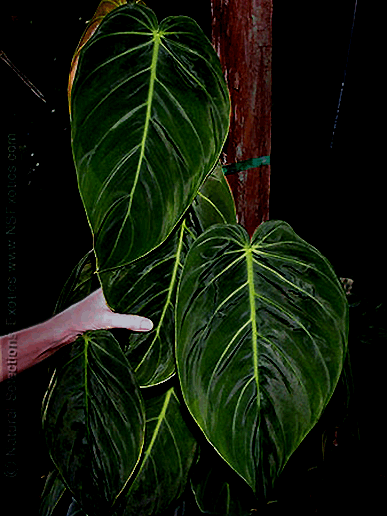![]()
Aroids and other genera in the Collection
Take the Tour Now?
Orchids
The
Exotic Rainforest
Plants in
the Exotic Rainforest Collection
Images on this website are copyright protected. Contact
us before attempting to reuse.
In depth information on how to grow Philodendron species, Click this Link
Within our collection we have many species of Philodendron. If you are seeking other photos, click this link
Philodendron gigas Croat

According to noted palm expert and aroid grower Leland Miyano in Hawaii, "Philodendron gigas is absolutely beautiful, velvety and large." He adds, "Leaves are greater than three to four feet long!" According to the scientific description, the blades can reach 125cm (4.25 feet).
Endemic to Panama, Philodendron gigas is a hemiepiphytic Philodendron sp. A hemiepiphyte (hem-a-EPA-fit) is one that can grow either from the ground up the side of a tree or send roots from a tree branch down to the ground. Typically, hemiepiphytes are carried up into the host as a seed eaten by a bird and then deposited on a branch in the bird's droppings. This species can climb high in the trees, typically 15 to 20 meters (50 to 65 feet) up the side of the host. P. gigas grows as an appressed climber (pressed close to the host tree). The incredibly beautiful sub-coriaceous (less than leathery) leaves range from olive green to dark green and are both elongated, triangular, ovate or narrowly ovate and velutinous (velvety) in appearance. The petiole is "D" shaped instead of round.
Philodendron species, and especially hybrid forms, are known to be highly variable and not every leaf of every specimen will always appear the same. This link explains in greater detail the scientific principle of natural variation and morphogenesis. Click here.
According to the scientific description written and published by Dr. Tom Croat of the Missouri Botanical Garden, Philodendron gigas is found exclusively in the Canal Area of Panama where it is known only along the El Llano to Cartí road in both Panamá Province and in the Comarca de San Blas at 300 to 375 meters (950 to 1200 feet) in elevation in pre-mountainous wet rain forest and tropical wet rain forest areas. But interestingly, even though Dr. Croat's scientific description of Philodendron gigas clearly states the species is endemic (exclusive) only to Panama, according to the TROPICOS (a service of the Missouri Botanical Garden) global mapping system the species is shown to be found in Panama, Colombia, Ecuador and Brazil. I suspect there is a discrepancy in the information input into the Google map system since all scientific information available indicates the rare species is found only in a small area of Panama.
Philodendron gigas is capable of producing up to 7 inflorescences per axil with inflorescence tubes that are white tinged with red on the outside. The inside of the spathe is dark red tending towards violet. The spathe appears to be a hood and typically measures 7.5cm in length (3 inches). The seed berries are greenish tending towards white. Flowering in P. gigas occurs during the rainy season in Panama beginning in roughly July and lasting for several months.
We grow the species in extremely fast draining soil and allow it to climb a totem in to gain blade size. In less than one year the specimen has tripled in size. Philodendron gigas appears to do well in moderately bright light. Our specimen was acquired from Natural Selections Exotics in Fort Lauderdale and is still small. The photo above is courtesy Natural Selections Exotics.
Looking for a specimen? Contact
http:///
Natural Selections Exotics at
![]()
or Brian's Botanicals
http://www.briansbotanicals.net/

If
you are seeking information on other rare species, click on "Aroids and other genera in the Collection" at the top and look for the
Want to learn more
about aroids?
Join the
International Aroid Society:
http://www.exoticrainforest.com/Join%20IAS.html